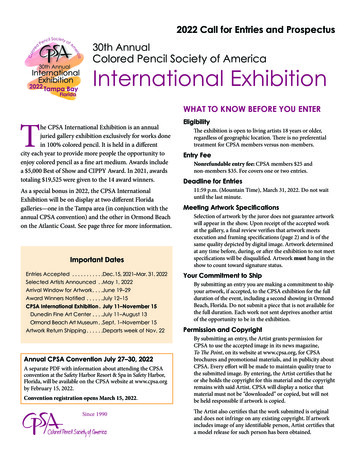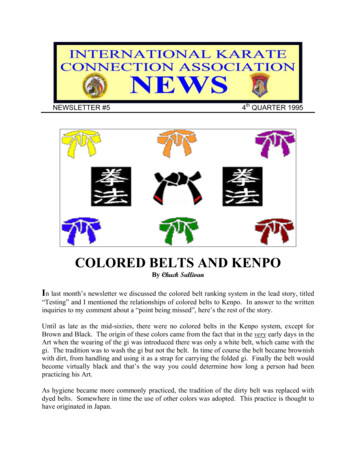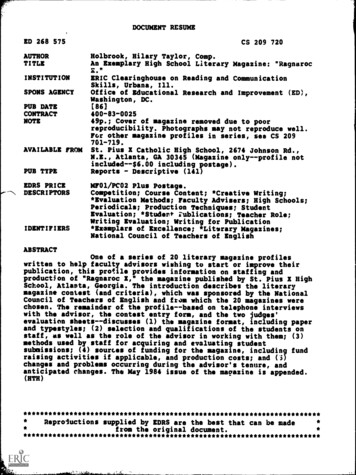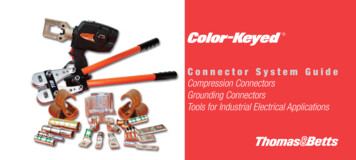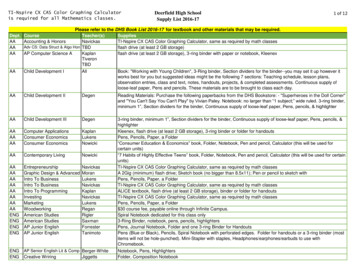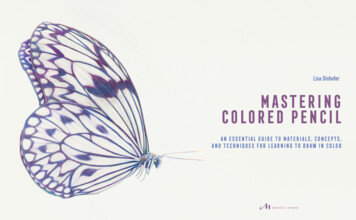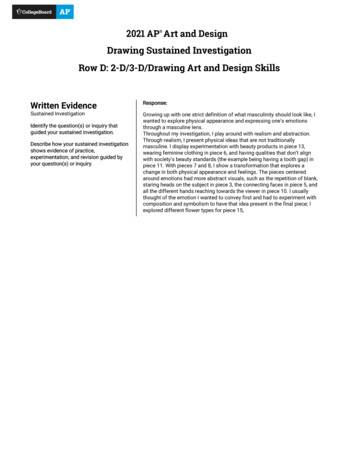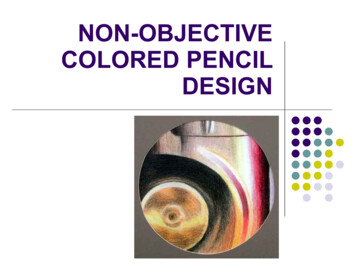
Transcription
NON-OBJECTIVECOLORED PENCILDESIGN
OBJECTIVESCreate a non-objective design from a magazinephoto using a viewfinder. Know, understand, and utilize the elements of artand principles of design. Learn the art style of Non-Objective Art andartists who used this style. Make judgments on great compositions anddesign elements. Find beauty in unsuspectedplaces. Develop skills in using colored pencils.
MATERIALS Viewfinders (circular - made using tagboardand compass)MagazinesPencilEraserPrismacolor colored pencilsWhite drawing paper – 12” squareCompass (10” - 11” diameter)Ruler
Elements of ArtThe elements of art are the parts of an artworkthat an artist plans. The elements are: Color Value Line Shape Form Texture Space
COLORColor (hue) is one of the elements of art. Artists usecolor in many different ways. The colors we see are lightwaves absorbed orreflected by everything around us. In nature, a rainbowis white light that is broken apart by the moisture in theair. People discovered that white light can be broken apartusing tools like prisms or spectroscopes. The colors of the visible light spectrum are red, orange,yellow, green, blue, indigo and violet. White light consists of all of the colors mixed together.The color of an object depends on how it absorbs and/orreflects light. If an object absorbs all of the lightwavelengths, it will appear black. If it reflects all of them,it will appear white. If an object absorbs all wavelengthsexcept red, for example, it will look red.
VALUEValue is one of the elements of art. Value is the lightness or darkness of a color. You can get different values of a color by mixingits tint (white) and shade (black).
LINELine is one of theelements of art. You can find lineseverywhere you look.
SHAPEShape is one of theelements of art. Whenlines meet, shapes areformed. Shapes are flat. Someshapes are geometric,such as squares, circles,triangles, rectangles, andovals. Other shapes areorganic or irregular. GEOMETRICORGANIC
FORMForm is one of the elements of art. Forms are three-dimensional - they haveheight, width and depth. Shapes are flat; forms are not.
TEXTURETexture is one of theelements of art. Texture is the waysomething feels when youtouch it. Artists also create theillusion of texture inartworks such aspaintings, drawings andprints. Smooth, shiny,roughWet, slippery,hardSoft, shiny,silkyWindy, leafy,cloudy
SPACESpace is one of the elements of art. Space is an empty place or surface in or around awork of art. Space can be two-dimensional, three-dimensional,negative and/or positive. You can easily see the positive and negative spacein this sculpture. Artists also create positive andnegative space in two-dimensional artworks.
Principles of DesignThe principles of art help artists plan their artand think about how other people will react tothe artwork. The principles are: Balance Contrast Pattern Rhythm Emphasis Unity Variety
BALANCEBalance is one of the principles of art whichdescribes how artists to create visual weight. Artists think about how to make their worksbalanced by using elements such as line, shapeand color. There are several ways to balance anartwork:
CONTRAST Contrast is one of the principles of art which createsexcitement and interest in artworks. Two things that are verydifferent have a lot of contrast.White and black have the greatest amount of contrast.Complementary colors also have a high contrast.Artists use high contrast to make something show up. InWheatfields with Ravens, Vincent van Gogh used highcontrast colors to make the yellow wheat fields stand outagainst the dark blue sky. Artists may choose low contrast fora softer look, as Claude Monet did in this painting of a bridge.
PATTERNPattern is one of the principles of art. Artistscreate pattern by repeating a line, shape or colorover and over again. Lines create patterns on theheaddress of the Golden Effigyof King Tutenkhaman.In "Water Lilies," Claude Monetrepeats the pattern of waterlilies floating on the pond.
RHYTHMRhythm is one of the principles of art. Visual rhythm makes you think of the rhythmsyou hear in music or dance. Artists create visual rhythm by repeatingart elements and creating patterns. In Okazaki, Ando Hiroshige's bridge supportscreate a rhythm that leads your eyes through the landscape.
EMPHASISEmphasis is one of theprinciples of art. Artists use emphasisto make certain parts of their artworkstand out and grab your attention.The center of interest or focal point isthe place the artist draws your eye tofirst. In this painting, "The Letter," MaryCassatt empasized the envelope bypainting it white against the darkpatterns of the woman's dress. Shealso placed the envelope in the centerof the painting to draw your eye to it.
UNITYUnity is one of the principles of art. Unity is the feeling that everything in the workof art works together and looks like it fits. Gustave Caillebotte usedshape to create unity.Repetition of shape and colorcan make an artwork unified.
VARIETYVariety is one of the principles of art. Variety occurs when an artist createssomething that looks different from the rest of theartwork. An artist may use variety to make you look at acertain part or make the artwork more interesting. Jasper Cropsey painted alarge tree to create varietyin his landscape, "In theValley."
FIVE MODES OF DESIGN1.2.3.4.Naturalism – photo realisticRealism – representationalStylized – simplification of detailsAbstraction – distortion and overlappingto create new shapes5. Non-Objective – no recognizable object,elements producing the principles ofdesign
NONOBJECTIVE ARTArtworks having no recognizable subject matter(not recognizable as such things as houses,trees, people, etc.)Wassily KandinskyJoan Miro
NON-OBJECTIVEMODE OF DESIGNThis is a project that will test you to create adesign using the Non-Objective Mode of Design.Non-objective is the type of design that is full ofcolors, shapes, lines, values, forms, textures,using the Principle of Design to make acomposition that has NO recognizable subject orobjects. It instead relies on the elements andprinciples of design to create a balancedinteresting composition having a center ofinterest, directional movement, rhythmic shapes,variety of size, balance of values and colors.
PROCEDURES VIEWFINDERSUse a compass and tagboard to create aseries of different sized circular viewfinders. Draw 3-5 different sized circles with acompass. Cut them out with an X-acto knife or scissorsusing a cutting mat.
NON-OBJECTIVEMAGAZINE DESIGNS Look in magazines for interesting shapes,colors, contrast of values, variety of sizes, aninteresting area off center, gradations ofcolors and values.Make sure you can’t really see what thepicture is. Instead, focus on the design yousee with the viewfinder.If the design has all the principles of goodcomposition then tape the finder over it andsave. Find at least three.
DRAWING DESIGNChoose the best non-objective design withthe viewfinders. Use a compass and draw an 11” diametercircle on 12"x18" drawing paper. Make a square around it with a ruler, find themiddle and draw a line dividing it in bothdirections making a cross in the middle. Do the same on the small non-objectivedesign viewfinder picture.
DRAWING AND TRANSFERINGEnlarge the most important lines by using the grid as away of keeping good proportion. When finished with the enlarging, graphite the backand transfer to good drawing paper to make the finaldrawing. Complete Introduction to Colored Pencils packet.Practice using soft light layers of colored pencils toachieve soft gradations and different colors. Always startwith the lightest colors first and then go to the darkerones. Use a white pencil to blend the layers together.Practice the colors you need on the side of the paperoutside the circle.
Complete Introduction to Colored Pencils packet. Practice using soft light layers of colored pencils to achieve soft gradations and different colors. Always start with the lightest colors first and then go to the darker ones. Use a white pencil to blend the layers together. Practice the col
